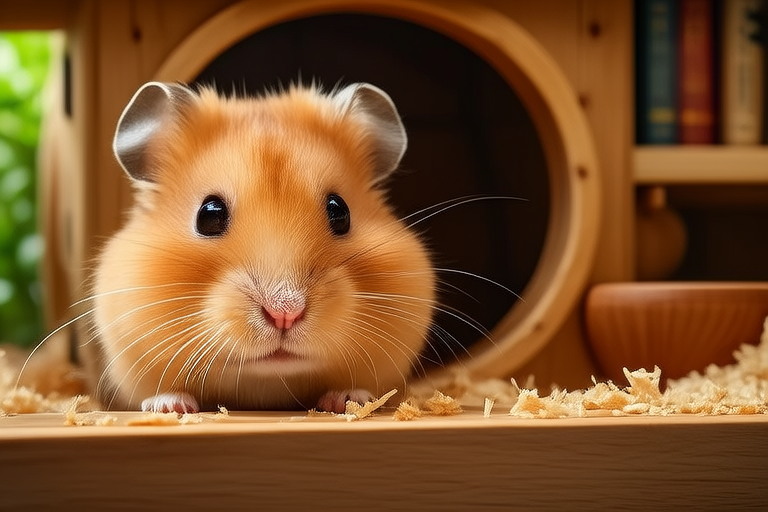How To Create The Ultimate Habitat For Your Golden Hamster
Welcome to the world of golden hamsters! These delightful little creatures are popular pets known for their cute appearance and playful nature. Creating the perfect habitat for your golden hamster is crucial for their health and happiness. This guide will walk you through the essential elements of a hamster’s living space, including appropriate cage size, bedding materials, hiding spots, exercise wheels, and feeding stations. We’ll also cover temperature and lighting needs, safety precautions, and enrichment ideas to ensure a healthy, happy hamster. Finally, we’ll provide some养护tips and discuss common mistakes to avoid.
Choosing the Right Cage Size
The first step in creating an ideal habitat for your golden hamster is selecting the right cage. While many people believe that hamsters don’t need much space, they are actually quite active and require plenty of room to explore and play. A minimum cage size of 24 inches long by 12 inches wide by 12 inches high is recommended for one hamster. However, if you have the space, a larger cage would be even better.
It’s important to choose a cage with a solid bottom rather than wire flooring. Wire floors can cause discomfort or injury to your hamster’s delicate paws. Additionally, consider the type of material the cage is made from. Stainless steel cages are durable and easy to clean, but they can be expensive. Plastic cages are more affordable and come in various colors, but they may not last as long and can be difficult to clean thoroughly.
Selecting Suitable Bedding Materials
Bedding is an essential part of your hamster’s habitat, providing comfort and helping to absorb waste. There are several options available, each with its own pros and cons. Wood shavings, such as those made from aspen or pine, are popular choices. However, avoid cedar shavings as they contain oils that can irritate your hamster’s respiratory system. Paper-based bedding, like Carefresh or Yesterday’s News, is another excellent option. It’s dust-free, absorbent, and easy to clean. You can also use recycled paper towels or newspaper, but make sure to avoid glossy or colored sections.
In addition to regular bedding, it’s a good idea to provide some soft nesting material for your hamster to burrow into. Safe options include shredded tissue paper, cotton wool, and small amounts of untreated hay. Avoid using fluffy materials like cotton balls or pieces of fabric, as these can pose a choking hazard.
Providing Hiding Spots and Nesting Areas
Golden hamsters are naturally burrowing animals, so it’s important to provide them with plenty of opportunities to hide and nest within their cage. You can purchase commercially available hideouts or create your own using cardboard boxes or PVC pipes. Ensure that any hiding spots you provide are large enough for your hamster to comfortably fit inside and turn around.
Aside from designated hideouts, you can also add tunnels or tubes to your hamster’s habitat. These allow your pet to explore and exercise while staying safe and secure. Be mindful of the size and shape of tunnels, ensuring they are wide enough for your hamster to move through easily but not so large that they become dangerous.
Adding an Exercise Wheel
Exercise wheels are a vital component of your hamster’s habitat, allowing them to stay active and burn off excess energy. When choosing an exercise wheel, look for one that is large enough for your hamster to run on comfortably without hunching their back. A diameter of at least 8 inches is recommended. Wheels with solid running surfaces are safer than those with wire mesh, as they prevent injuries and reduce noise.
Position the exercise wheel away from the feeding area to avoid contamination. Make sure it’s securely fastened to the cage, and check regularly for wear and tear. Replace the wheel if you notice any damage or signs of instability.
Setting Up Feeding Stations
Your hamster’s diet plays a significant role in their overall health and well-being. Provide a high-quality hamster mix that includes a variety of seeds, grains, and pellets. Avoid mixes with too many nuts or sunflower seeds, as these can lead to obesity. Supplement their diet with fresh vegetables and fruits, offering small portions of items like carrots, broccoli, and apple slices. Rotate the types of produce you offer to keep things interesting.
Set up a food dish near the entrance of the cage to encourage your hamster to come out and eat. Make sure the dish is shallow and easy to access. Clean the dish daily and refill it with fresh food to maintain hygiene. Consider adding a water bottle with a sipper tube for easy access to fresh water.
Temperature and Lighting Needs
Golden hamsters thrive in moderate temperatures between 65°F and 75°F (18°C and 24°C). Avoid placing their cage in direct sunlight or near heat sources, as this can cause overheating. Similarly, keep them away from drafty areas or air conditioning vents to prevent chilling.
While hamsters are nocturnal animals, they still benefit from exposure to natural light during the day. Place their cage in a location where they can receive indirect sunlight, but avoid direct sunlight which can cause overheating. If necessary, provide additional lighting during the evening hours to mimic their natural environment. Use a low-wattage bulb or LED light to avoid excessive heat generation.
Safety Precautions
Ensuring your hamster’s safety is paramount. Remove any objects that could pose a choking hazard, such as small toys or loose strings. Check regularly for any potential hazards, including sharp edges or gaps in the cage that might trap your hamster’s limbs.
Be cautious when handling your hamster, as they can bite if startled or frightened. Always approach them gently and allow them time to adjust to your presence. Keep children and other pets away from the cage to prevent accidents.
